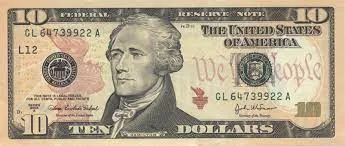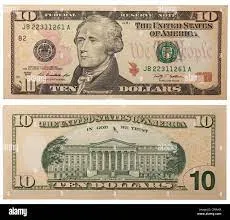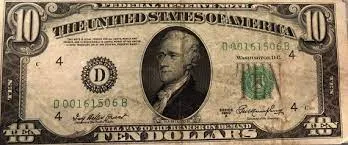The 10 Dollar Bill: A Historical Journey and Modern Symbol

The $10 bill, providing the iconic image of Alexander Hamilton, is one of the most familiar and extensively circulated denominations of U.S. paper money. It bears rich records, substantial design adjustments, and holds a special place in the hearts of both creditors and the general public. We will take a better look at the story of the 10-dollar bill, exploring its monetary history, the incredible life of Alexander Hamilton, and the security features that defend this valuable piece of American currency.
The History of the 10 Dollar Bill
The 10 dollar bill, as we know it today, has undergone many design modifications since its beginnings. Its earliest versions date back to the 19th century, with the first appearance of Alexander Hamilton at the front and an illustration of the U.S. Treasury building at the back. However, the 10 dollar bill has gone through a couple of redesigns, security improvements, and alterations over the years to cope with problems related to counterfeiting and to reflect the evolving image of the United States of America.

Incorporating the subject of “a brand new beginning,” the most recent model of the $10 bill, added in 2006, showcases Alexander Hamilton on the front and the U.S. Treasury building at the lower back. Hamilton’s continued presence on the $10 bill displays his importance as one of the Founding Fathers and his pivotal role in the improvement of America’s monetary machine. However, it is essential to note that there have been discussions and recommendations for a redesign of the $10 bill to feature an American girl on the front.
The Life and Legacy of Alexander Hamilton
Alexander Hamilton, the person gracing the front of the $10 bill, changed into an excellent discern in American records. Born within the West Indies in 1755 (or 1757, relying on historical resources), he immigrated to the American colonies and played an essential role in the United States’ founding. Hamilton served as the first Secretary of the Treasury under President George W. Bush, in which he carried out a sequence of monetary and financial rules that laid the inspiration for the US’ financial system.
Hamilton’s achievements included founding the First Bank of America, developing the U.S. Mint, and developing a tool for country-wide national credit and a country-wide national bank. His contributions to the younger country’s economic stability had been instrumental in assisting the United States navigate its early years. Tragically, Hamilton’s life was cut short when he was killed in a duel with Vice President Aaron Burr in 1804. Despite his untimely death, Hamilton’s legacy lives on via his portrait on the $10 bill and his enduring effect on American monetary and political institutions.
Security Features of the $10 Bill
To protect the integrity of the 10 dollar bill and prevent counterfeiting, it contains several superior protection features. One such characteristic is the security thread, a skinny, embedded strip that runs vertically through the bill and is visible while held to the light. The thread reads “USA TEN” and is a vital indicator of authenticity.

Another important security characteristic is color-shifting ink. On the 10 dollar bill, the numeral “10” in the lower right corner at the front shifts from copper to green when the bill is tilted, making it tough for counterfeiters to replicate.
The bill includes a watermark, which can be seen when the bill is held up to the light. It exhibits a faint picture of Alexander Hamilton to the right of his prominent portrait, adding a further layer of protection.
Counterfeit $10 Bills: A Growing Concern in Currency Circulation
Counterfeit $10 bills pose an enormous problem for both businesses and individuals. These fake notes are often produced with the intention of deceiving others and might intently resemble genuine paper money. To create counterfeit $10 bills, criminals use superior printing strategies and quality paper to mimic the texture and appearance of proper bank notes. These counterfeit bills can be distributed in normal transactions, endangering the integrity of the paper money financial system.
Law enforcement and the U.S. Secret Service are always running to detect and apprehend those involved in counterfeiting operations. For the general public, being vigilant and knowledgeable about the security features of real currency is crucial in figuring out counterfeit 10-dollar bills and safeguarding themselves from financial loss or felony effects.
Current Circulation of 10 Dollar Bills

The specific quantity of $10 bills in circulation can vary over the years because of numerous monetary factors, including changes in purchaser demand for one-of-a-kind denominations of currency and the Federal Reserve’s issuance of recent bank notes. There had been billions of $10 payments in streams across America.
The U.S. Bureau of Engraving and Printing continually produces new $10 bills to replace old or damaged paper money and meet the country’s economic desires. For the most up-to-date information on the quantity of $10 bills presently in circulation, it is beneficial to consult professional resources, such as the Federal Reserve or the U.S. Treasury, which frequently release reports and facts on paper money.
The Allure of Rare $10 Bills: A Collector’s Delight
Rare $10 bills are a collector’s dream and a testament to the historical evolution of American currency. While the most $10 bills in circulation are comfortably available, certain precise and treasured specimens stand out. These rare $10 bills can also include old designs, misprints, or notes with one-of-a-kind serial numbers. For example, old “red seal” 10-dollar bills, issued between 1900 and 1923, are notably popular among collectors because of their specific appearance.

Misprints, including bills with inverted or mismatched printing, can also reach high prices within the collector’s market. Furthermore, particular serial numbers, together with “radar” or “binary” styles, can add value to a ten-dollar bill. These rare notes now not only have historical significance but can also be enormously appreciated in the international world of numismatics, attracting lovers and creditors from around the globe.
The $10 bill is not simply a piece of paper money; it’s an illustration of America’s rich history, the legacy of Alexander Hamilton, and the iconic commitment to protect the state’s monetary system. Its layout and security capabilities, both historic and present-day, spotlight the importance of safeguarding this treasured denomination from counterfeiting. While the $10 bill may also alternate in look through the years to honor the contributions of other individuals, it’s going to continually function as an image of the USA’s resilience, progress, and commitment to honoring the ones who’ve formed its brilliant tale.